Abstract
Cephamycin C is a β-lactam antibiotic that has broad gram-negative activity and is resistant to degradation by β-lactamases and safe for use in animals. In colostrum-fed calves infected with Escherichia coli strain B44, cephamycin C administered by gavage at 31.3 to 1,000 mg per calf (0.75 to 24 mg/kg) twice a day for 6 days starting at 20 h post-inoculation eliminated the diarrhea and reduced the mortality from 90% in infected, nonmedicated calves to 14% in infected, medicated calves (P < 0.01). Comparable results were obtained with a shorter treatment regimen (30 mg of cephamycin C per calf [0.71 mg/kg] twice a day for 3 days). In colostrum-fed piglets infected with E. coli strain P155 and housed in cages, cephamycin C administered prophylactically by gavage at 12.5 mg per piglet (10.4 mg/kg) twice a day for 4 days completely prevented both diarrhea and mortality, whereas nonmedicated piglets had 100% diarrhea and all died. When eight doses of cephamycin C were given therapeutically starting at 6 h post-inoculation, mortality was reduced from 79 to 23% (P < 0.02), and diarrhea was eliminated in the surviving medicated piglets by 4 days post-inoculation. In infected suckling piglets, cephamycin C administered therapeutically by gavage at 12.5 mg per piglet twice a day for 3 days starting at 6 h post-inoculation, diarrhea and mortality were reduced (P < 0.05): infected, nonmedicated piglets had 87% diarrhea and 75% mortality, whereas infected, medicated piglets had 25% diarrhea and 31% mortality. All surviving medicated piglets had solid feces by 2 days post-inoculation. Thus, cephamycin C was highly effective in restoring the calves and piglets to good health by eliminating diarrhea and reducing mortality.
Full text
PDF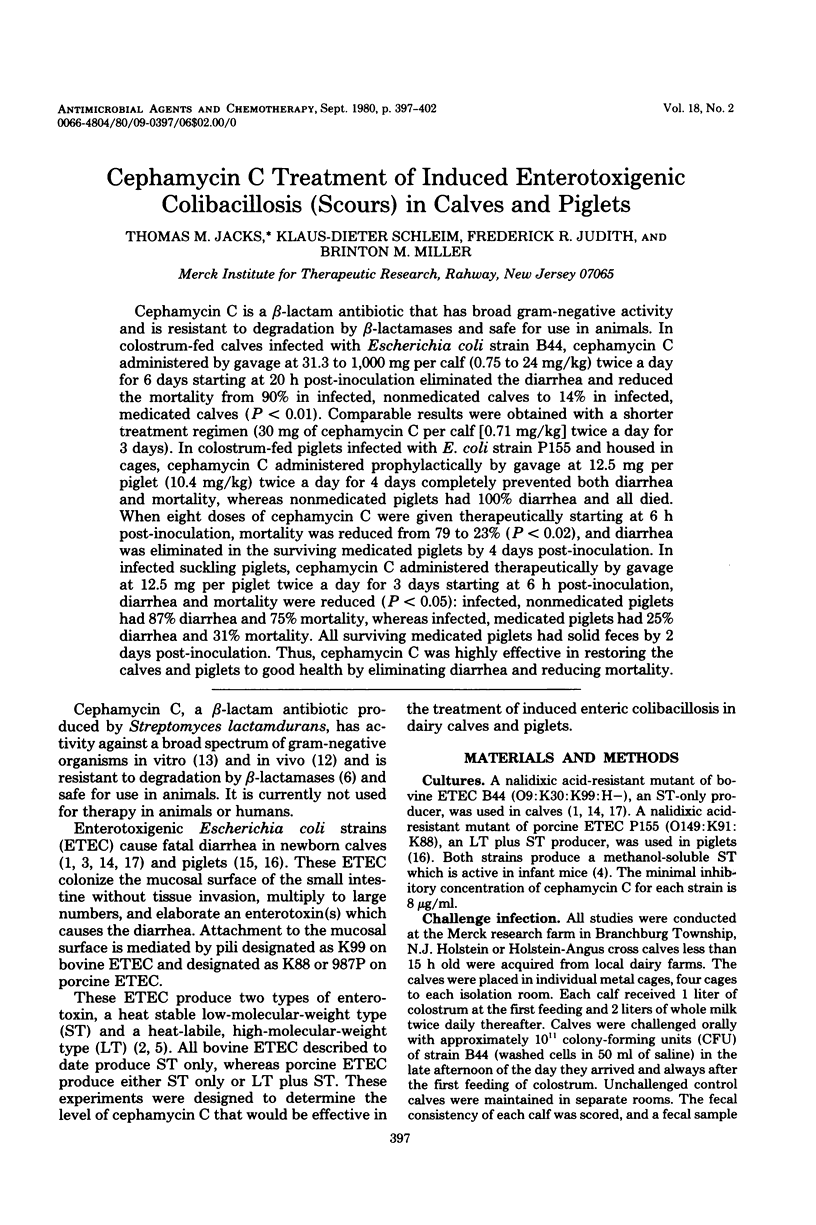
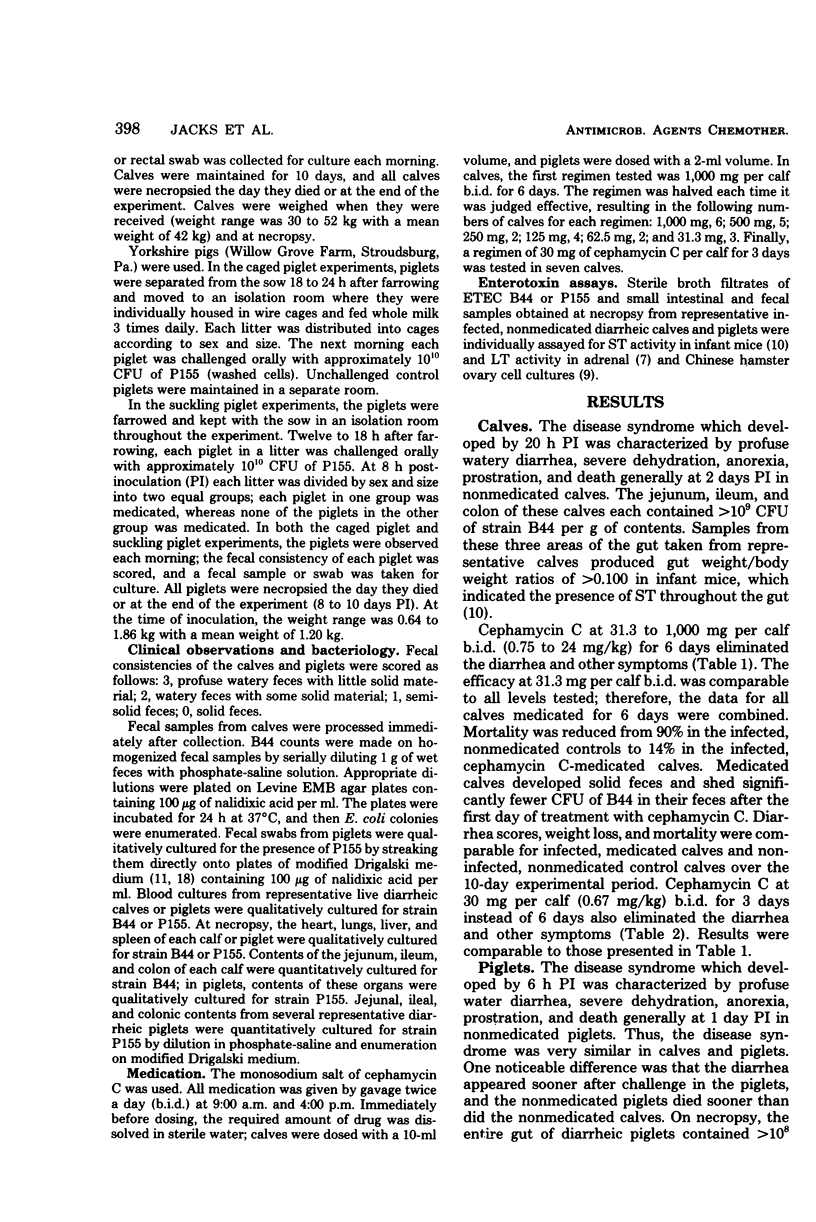
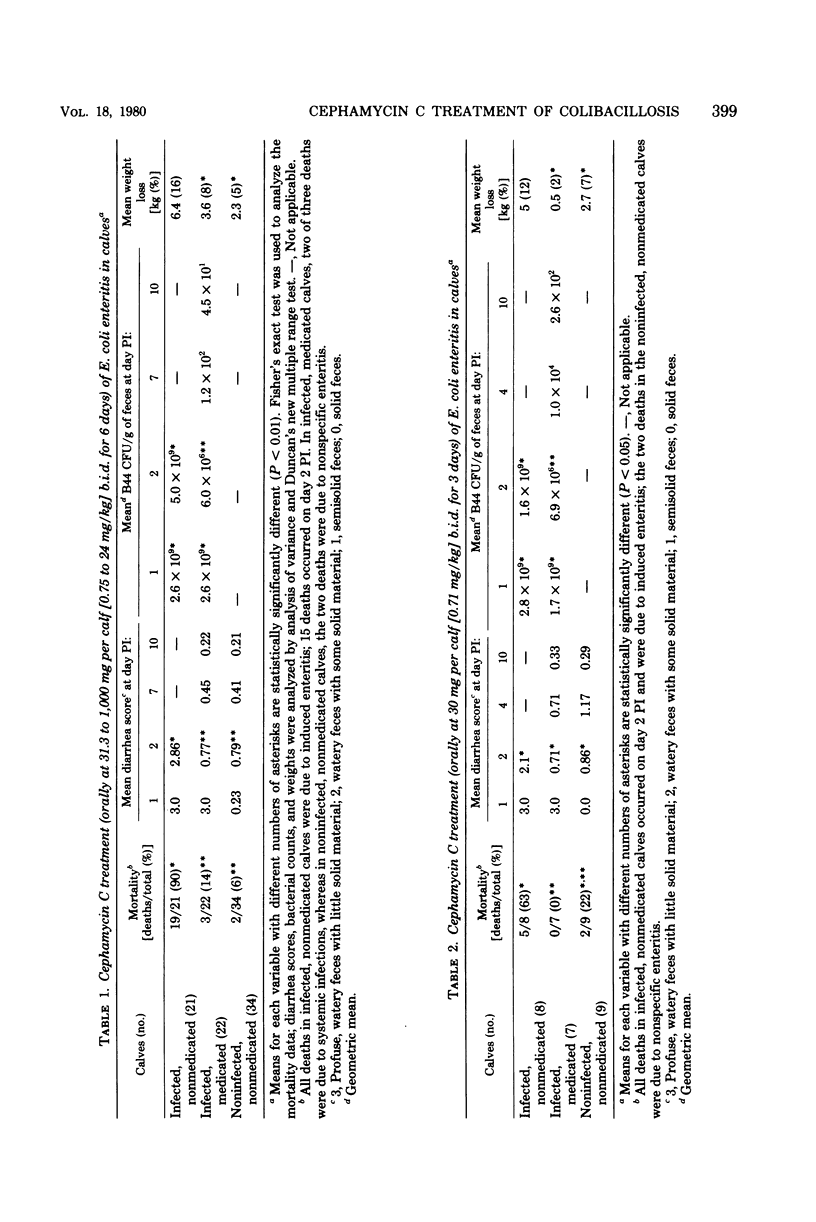
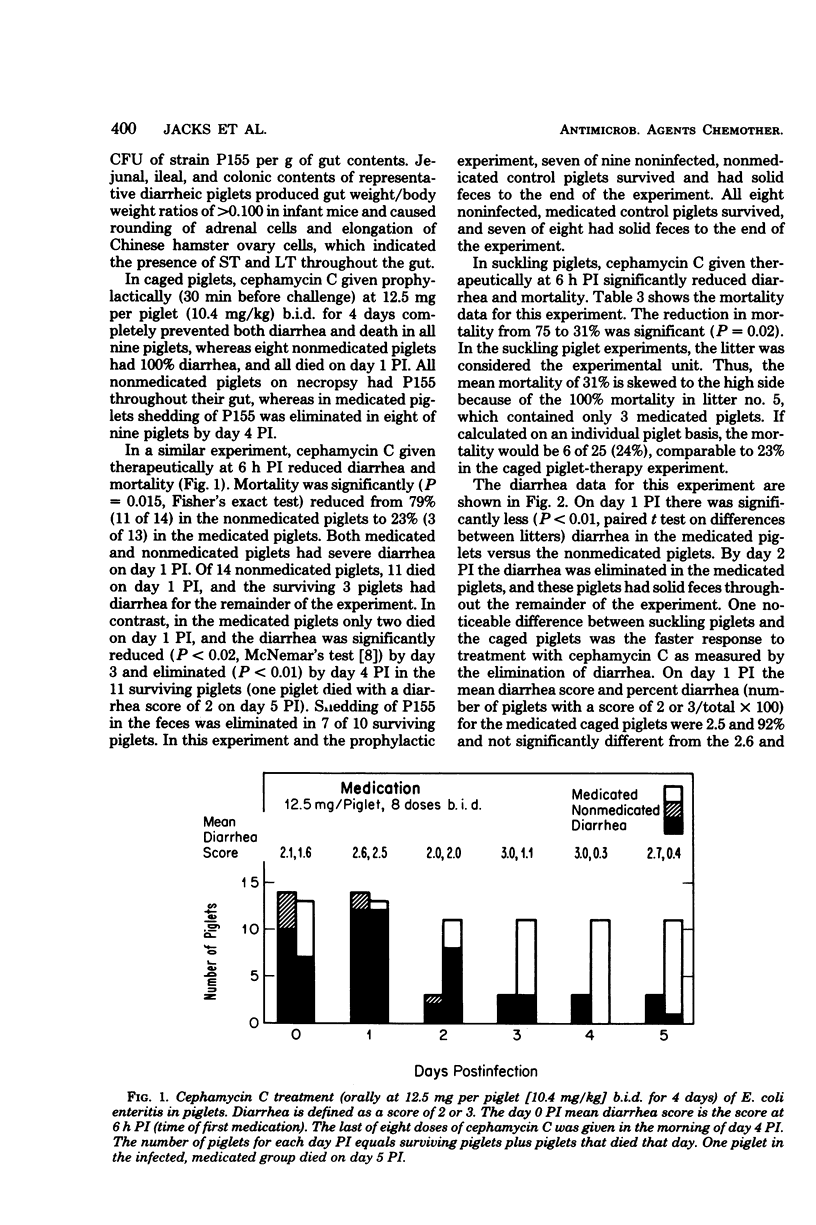

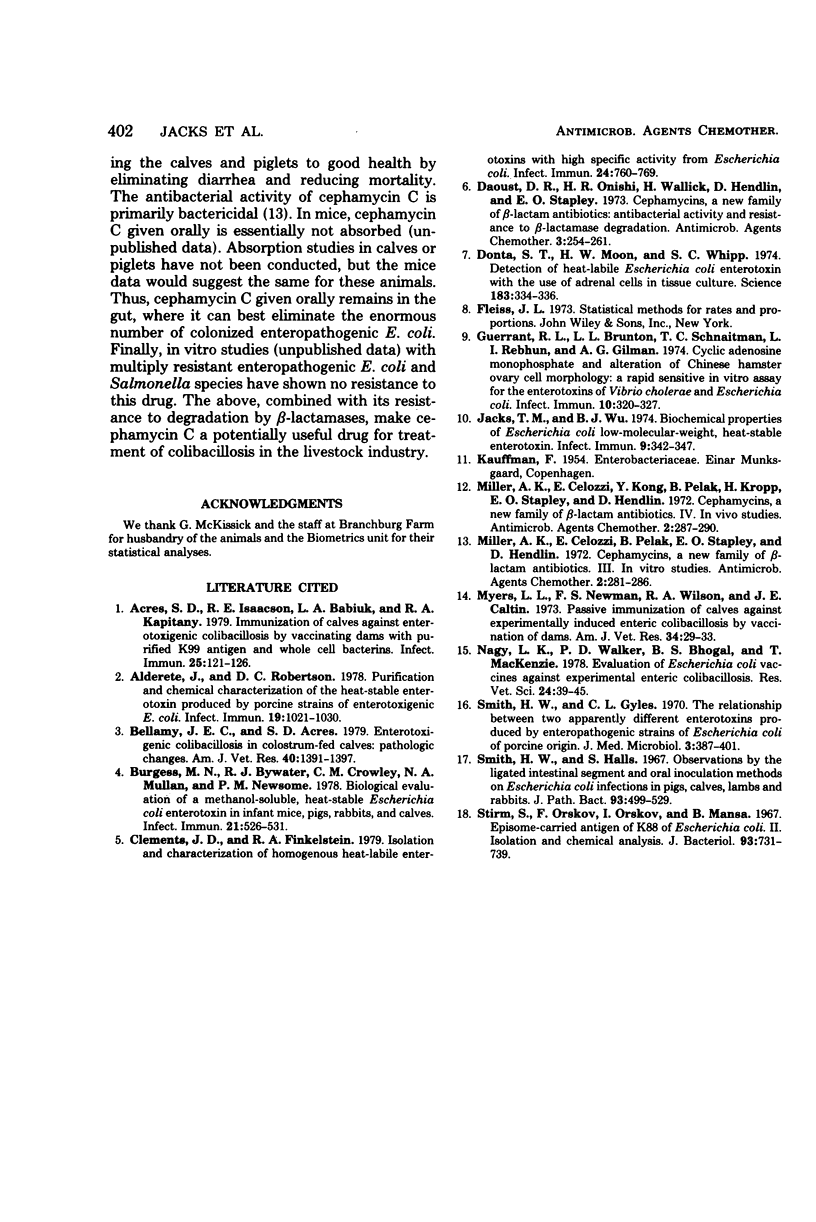
Selected References
These references are in PubMed. This may not be the complete list of references from this article.
- Acres S. D., Isaacson R. E., Babiuk L. A., Kapitany R. A. Immunization of calves against enterotoxigenic colibacillosis by vaccinating dams with purified K99 antigen and whole cell bacterins. Infect Immun. 1979 Jul;25(1):121–126. doi: 10.1128/iai.25.1.121-126.1979. [DOI] [PMC free article] [PubMed] [Google Scholar]
- Alderete J. F., Robertson D. C. Purification and chemical characterization of the heat-stable enterotoxin produced by porcine strains of enterotoxigenic Escherichia coli. Infect Immun. 1978 Mar;19(3):1021–1030. doi: 10.1128/iai.19.3.1021-1030.1978. [DOI] [PMC free article] [PubMed] [Google Scholar]
- Bellamy J. E., Acres S. D. Enterotoxigenic colibacillosis in colostrum-fed calves: pathologic changes. Am J Vet Res. 1979 Oct;40(10):1391–1397. [PubMed] [Google Scholar]
- Burgess M. N., Bywater R. J., Cowley C. M., Mullan N. A., Newsome P. M. Biological evaluation of a methanol-soluble, heat-stable Escherichia coli enterotoxin in infant mice, pigs, rabbits, and calves. Infect Immun. 1978 Aug;21(2):526–531. doi: 10.1128/iai.21.2.526-531.1978. [DOI] [PMC free article] [PubMed] [Google Scholar]
- Clements J. D., Finkelstein R. A. Isolation and characterization of homogeneous heat-labile enterotoxins with high specific activity from Escherichia coli cultures. Infect Immun. 1979 Jun;24(3):760–769. doi: 10.1128/iai.24.3.760-769.1979. [DOI] [PMC free article] [PubMed] [Google Scholar]
- Daoust D. R., Onishi H. R., Wallick H., Hendlin D., Stapley E. O. Cephamycins, a new family of beta-lactam antibiotics: antibacterial activity and resistance to beta-lactamase degradation. Antimicrob Agents Chemother. 1973 Feb;3(2):254–261. doi: 10.1128/aac.3.2.254. [DOI] [PMC free article] [PubMed] [Google Scholar]
- Donta S. T., Moon H. W., Whipp S. C. Detection of heat-labile Escherichia coli enterotoxin with the use of adrenal cells in tissue culture. Science. 1974 Jan 25;183(4122):334–336. doi: 10.1126/science.183.4122.334. [DOI] [PubMed] [Google Scholar]
- Guerrant R. L., Brunton L. L., Schnaitman T. C., Rebhun L. I., Gilman A. G. Cyclic adenosine monophosphate and alteration of Chinese hamster ovary cell morphology: a rapid, sensitive in vitro assay for the enterotoxins of Vibrio cholerae and Escherichia coli. Infect Immun. 1974 Aug;10(2):320–327. doi: 10.1128/iai.10.2.320-327.1974. [DOI] [PMC free article] [PubMed] [Google Scholar]
- Jacks T. M., Wu B. J. Biochemical properties of Escherichia coli low-molecular-weight, heat-stable enterotoxin. Infect Immun. 1974 Feb;9(2):342–347. doi: 10.1128/iai.9.2.342-347.1974. [DOI] [PMC free article] [PubMed] [Google Scholar]
- Miller A. K., Celozzi E., Kong Y., Pelak B. A., Kropp H., Stapley E. O., Hendlin D. Cephamycins, a new family of beta-lactam antibiotics. IV. In vivo studies. Antimicrob Agents Chemother. 1972 Oct;2(4):287–290. doi: 10.1128/aac.2.4.287. [DOI] [PMC free article] [PubMed] [Google Scholar]
- Miller A. K., Celozzi E., Pelak B. A., Stapley E. O., Hendlin D. Cephamycins, a new family of beta-lactam antibiotics. 3. In vitro studies. Antimicrob Agents Chemother. 1972 Oct;2(4):281–286. doi: 10.1128/aac.2.4.281. [DOI] [PMC free article] [PubMed] [Google Scholar]
- Myers L. L., Newman F. S., Wilson R. A., Catlin J. E. Passive immunization of calves against experimentally induced enteric colibacillosis by vaccination of dams. Am J Vet Res. 1973 Jan;34(1):29–33. [PubMed] [Google Scholar]
- Nagy L. K., Walker P. D., Bhogal B. S., Mackenzie T. Evaluation of Escherichia coli vaccines against experimental enteric colibacillosis. Res Vet Sci. 1978 Jan;24(1):39–45. [PubMed] [Google Scholar]
- Smith H. W., Gyles C. L. The relationship between two apparently different enterotoxins produced by enteropathogenic strains of Escherichia coli of porcine origin. J Med Microbiol. 1970 Aug;3(3):387–401. doi: 10.1099/00222615-3-3-387. [DOI] [PubMed] [Google Scholar]
- Smith H. W., Halls S. Observations by the ligated intestinal segment and oral inoculation methods on Escherichia coli infections in pigs, calves, lambs and rabbits. J Pathol Bacteriol. 1967 Apr;93(2):499–529. doi: 10.1002/path.1700930211. [DOI] [PubMed] [Google Scholar]
- Stirm S., Orskov F., Orskov I., Mansa B. Episome-carried surface antigen K88 of Escherichia coli. II. Isolation and chemical analysis. J Bacteriol. 1967 Feb;93(2):731–739. doi: 10.1128/jb.93.2.731-739.1967. [DOI] [PMC free article] [PubMed] [Google Scholar]


